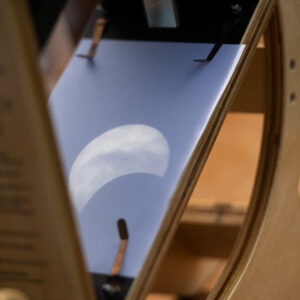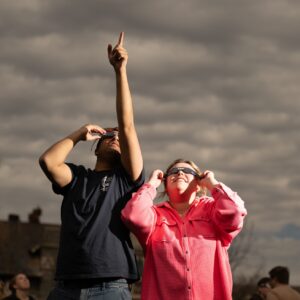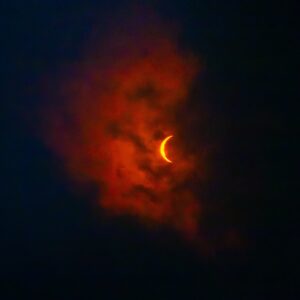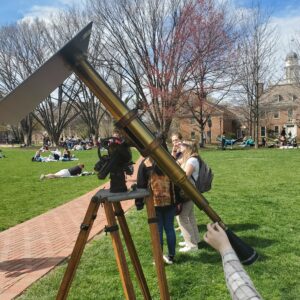Partial Solar Eclipse April 8, 2024
We viewed the solar eclipse from the Lafayette Quad!
Recap
We had an amazing time out on the quad on April 8th! Hundreds of students, faculty, and staff came out to view the partial eclipse. Clouds moved in as we neared maximum coverage, but everyone cheers when we got a few 10-20 second glimpses of the crescent sun. The event was featured on the College’s Instagram page.
Physics department
Four student volunteers and one staff member operated a pair of safely filtered telescopes, including one of our antique brass refractors successfully transformed into a Sun Funnel!
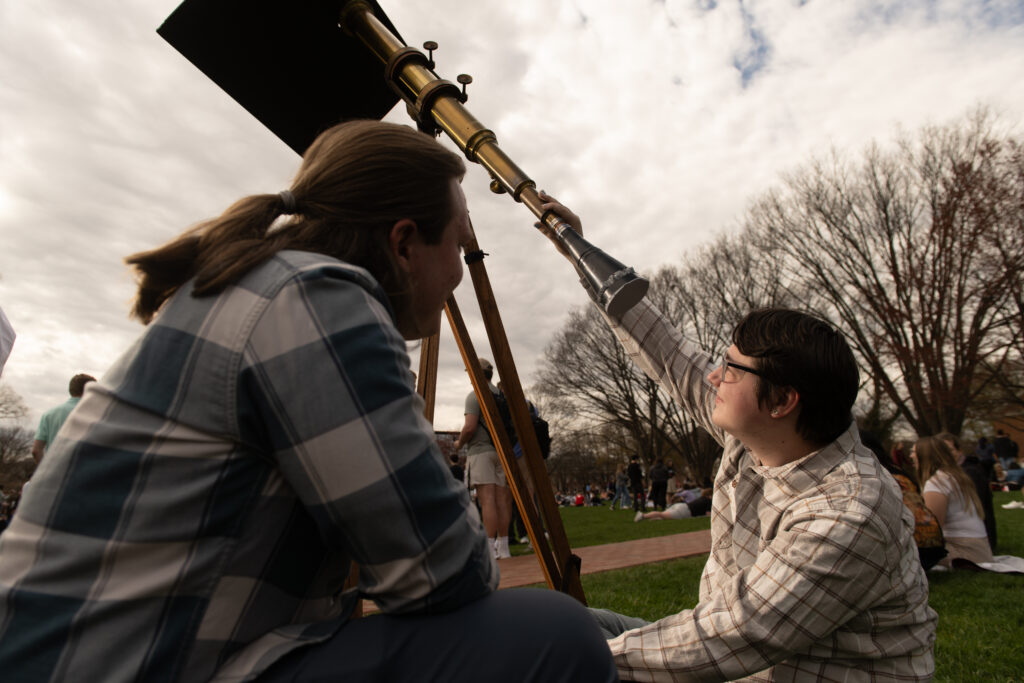
Physics majors Aidan Wensel ’25 and Lucas Lindenmuth ’25 view an image of the eclipse on a sun funnel. Photo by Adam Atkinson/Lafayette College Communications.
Astronomy Club
The Lafayette Astronomy Club brought six volunteers to operate three telescopes: two with safe solar filters on the front that the club built themselves, and one H-alpha telescope.
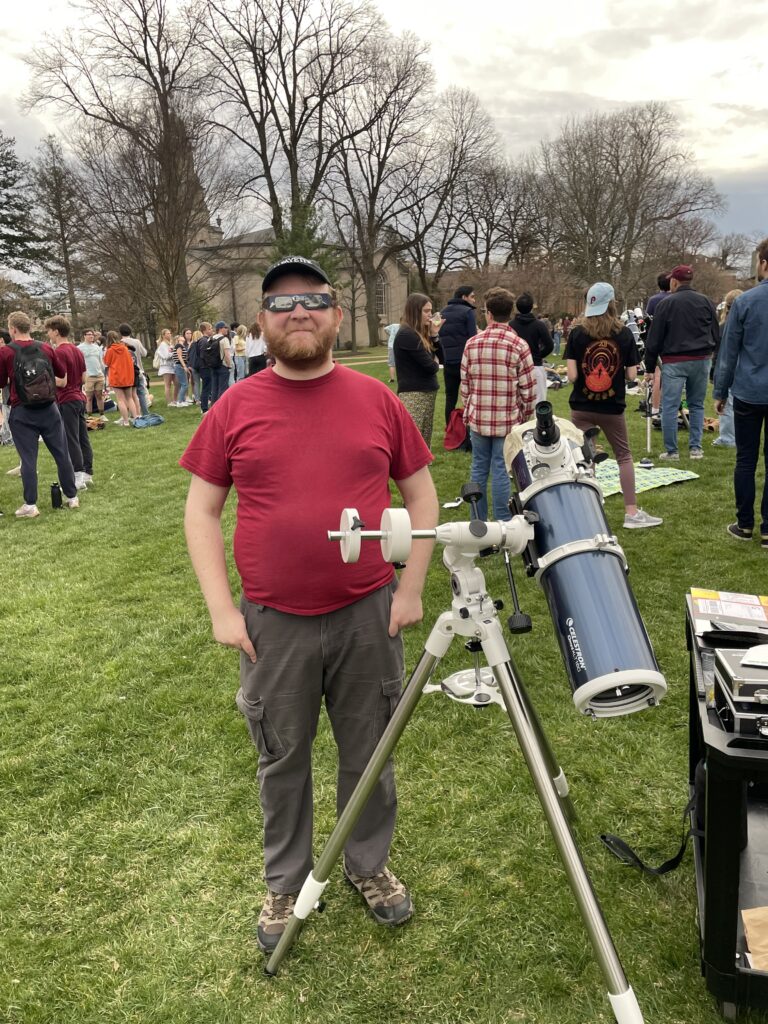
Dan Hoover ’25, President of the Lafayette Astronomy Club, shows off a safely filtered Celestron telescope. Photo by Jenna Tempkin ’24.
PHYS 108 Class
The PHYS 108: Astronomy class showed the eclipse through SunSpotters, and used globes to demonstrate why the path of totality is so narrow.
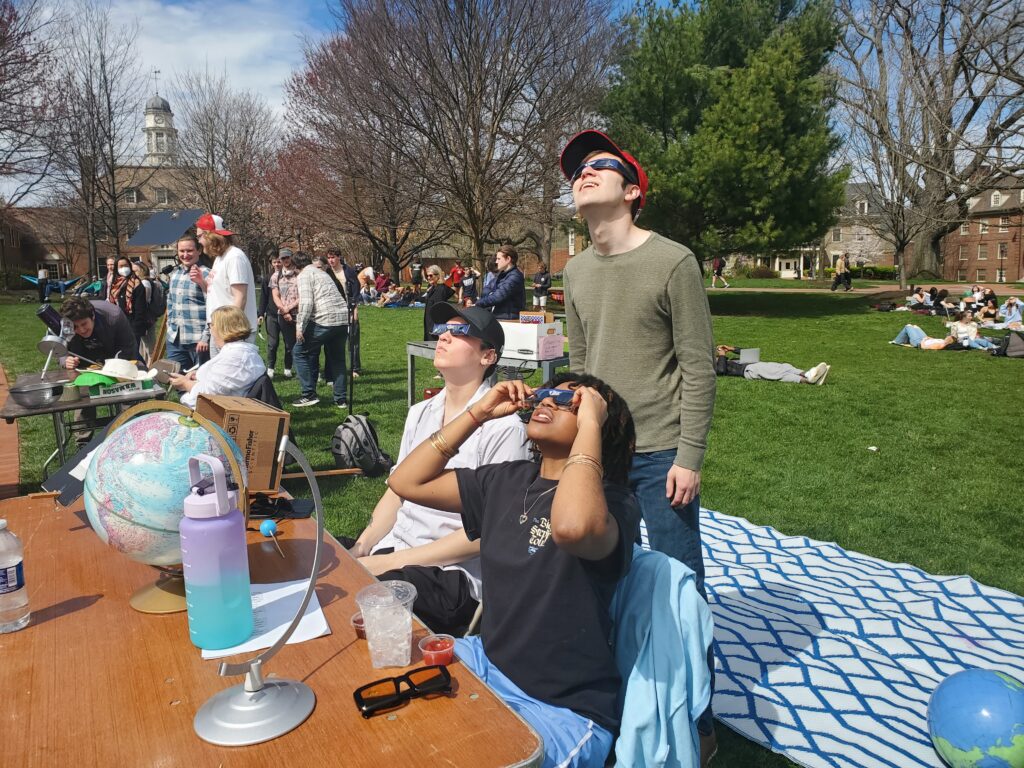
Grahame Ung ’24, Image Patterson ’25, and Ian Brown ’24 use eclipse glasses to safely observe the beginning of the eclipse. Image by Stephanie T. Douglas.
Original pre-event content
On April 8, 2024, a solar eclipse will sweep across North America from Mazatlán, Mexico to Prince Edward Island in Canada. Those lucky enough to be in the path of totality will see the Sun completely obscured by the Moon. Easton is not within that path, but we will see a spectacular partial eclipse with >91% of the Sun covered. As viewed from Easton, the eclipse will begin around 2:10 pm, reach maximum coverage around 3:22 pm, and end around 4:35 pm.

(Predicted maximum eclipse coverage in Easton from NASA’s Eclipse Explorer)
Safety
Never look directly at the Sun, even during the partial eclipse. Less than 1% of the Sun’s total light can damage your eyes – and Easton will always see at least 8% of the Sun’s surface. Do not look through cameras, binoculars, telescopes, or other lenses without proper filters in place.
Protect your eyes with eclipse glasses that are compliant with ISO standard 12312-2:2015 for safely viewing the Sun. Eclipse glasses are only for looking at the Sun with your eyes. Do not use eclipse glasses with cameras, binoculars, telescopes, or other lenses.
The Provost’s Office has provided funding for 3000 pairs of eclipse glasses. Glasses will be distributed from 10am-2pm in the Farinon atrium on Friday, April 5 and Monday, April 8. Glasses will be limited to 1 pair per Lafayette ID.
Other safe ways to observe the eclipse include pinhole projection and safely filtered telescopes: find out more about safe eclipse viewing from NASA. Especially for the type of partial eclipse visible from Easton, these other viewing methods can provide even more exciting Solar images than eclipse glasses.
Campus event
Members of the PHYS 108 Astronomy class, the Lafayette Astronomy Club, and the Physics Department will share safe viewing methods from 2-4pm on the quad.
The Astronomy Club is excited to show off their new H-alpha telescope, which will provide a unique view of the Sun’s active regions. PHYS 108 students will show you the Sun through pinhole projectors and SunSpotters, and can tell you about why eclipses happen. Finally, the Physics Department will give new life to one of our antique refractors as a sun funnel!
Students, faculty, and staff (including contracted staff) are all welcome to join us on the quad for the eclipse. Family members are also welcome. Note that we will not have extra eclipse glasses for guests, but we will have plenty of safe ways to view the eclipse even without glasses.
Weather
The partial solar eclipse will still be visible through thin and/or patchy clouds. As long as there is no threat of rain, we will plan to be out on the quad under partly cloudy skies.
If there is thick cloud cover and/or significant threat of rain, the calendar event will be updated with an alternate location or cancellation notice. We will provide these updates as early as possible. Please use your own best judgment about weather safety.
Acknowledgements
Thank you to the Provost’s Office for funding the purchase of eclipse glasses for campus, and to the Student Involvement Office for helping distribute the glasses.
Note
Information on this page does not constitute medical advice; individuals should consult their physician or ophthalmologist with any health concerns.
